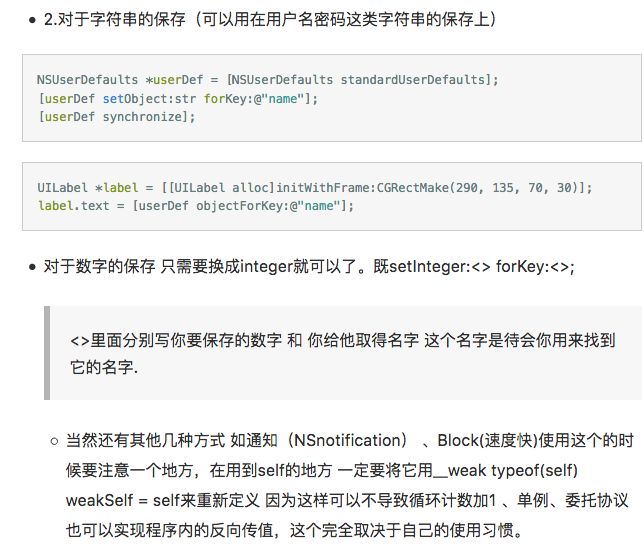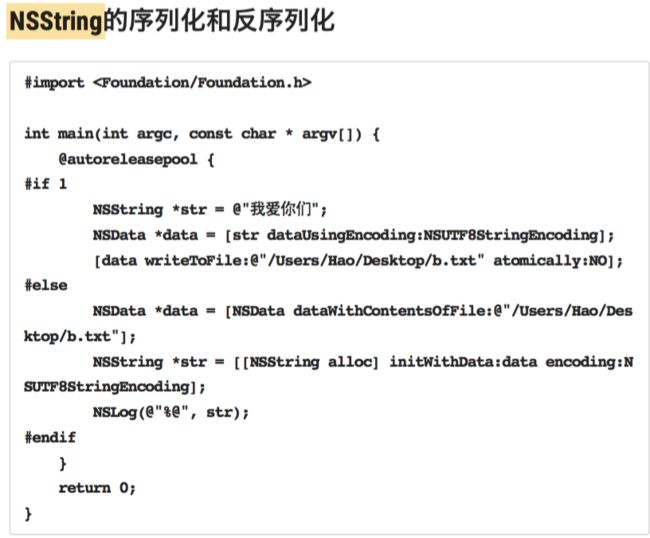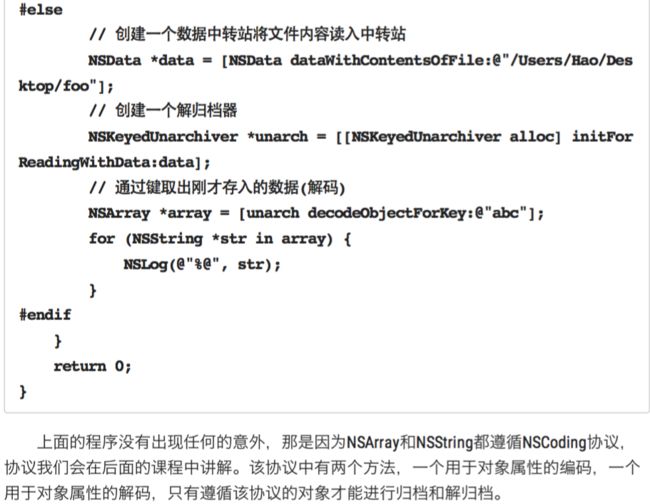1.概论
所谓的持久化,就是将数据保存到硬盘中,使得在应用程序或机器重启后可以继续访问之前保存的数据。在iOS开发中,有很多数据持久化的方案,接下来我将尝试着介绍一下5种方案:
- plist文件(属性列表)
- preference(偏好设置:NSUserDefaults)
- NSKeyedArchiver(归档)
- SQLite 3
- CoreData
** 备注:**
数据存储之前先了解一下沙盒:http://www.jianshu.com/p/34cda6a121db
2.plist文件
plist文件是将某些特定的类,通过XML文件的方式保存在目录中,可以被序列化的类型只有如下几种:
NSArray;
NSMutableArray;
NSDictionary;
NSMutableDictionary;
NSData;
NSMutableData;
NSString;
NSMutableString;
NSNumber;
NSDate;
1.获得文件路径
NSString *path = NSSearchPathForDirectoriesInDomains(NSDocumentDirectory, NSUserDomainMask, YES).firstObject;
NSString *fileName = [path stringByAppendingPathComponent:@"123.plist"];
2.存储
NSArray *array = @[@"123", @"456", @"789"];
[array writeToFile:fileName atomically:YES];
3.读取
NSArray *result = [NSArray arrayWithContentsOfFile:fileName];
NSLog(@"%@", result);
4. 注意
- 只有以上列出的类型才能使用plist文件存储;不能直接存储自定义模型对象,如果要自定义,则只能将自定义模型对象转换为字典存储
- 存储时使用writeToFile: atomically:方法。 其中atomically表示是否需要先写入一个辅助文件,再把辅助文件拷贝到目标文件地址。这是更安全的写入文件方法,一般都写YES
- 读取时使用arrayWithContentsOfFile:方法
- plist只能识别字典,数组
5.plist相关
如果想在plist文件中添加相关属性,有两个方法,
方法一:直接添加;
方法二:在其源代码中添加;
以添加常见的功能为例:
3.NSUerdefaults(偏好设置)
1.简介
对于NSUerdefaults来说 一般可以用来保存用户的偏好设置 比如登陆账号 密码这些。 除此之外 我们还可以用它来保存图片, 字符串 , 数字 和对象。它被保存到项目中的Plists文件里面里。保存图片 一般用它里面的两个方法 图片保存可以用PNG或者JPG对应的方法 先转换成NSData 再用NSUerdefaults保存 保存的时候为了让它马上存下来要用synchronize 。它还可以用来在程序间进行反向传值
2.使用方法
//1.获得NSUserDefaults文件
NSUserDefaults *userDefaults = [NSUserDefaults standardUserDefaults];
//2.向文件中写入内容
[userDefaults setObject:@"AAA" forKey:@"a"];
[userDefaults setBool:YES forKey:@"sex"];
[userDefaults setInteger:21 forKey:@"age"];
//2.1立即同步
[userDefaults synchronize];
//3.读取文件
NSString *name = [userDefaults objectForKey:@"a"];
BOOL sex = [userDefaults boolForKey:@"sex"];
NSInteger age = [userDefaults integerForKey:@"age"];
NSLog(@"%@, %d, %ld", name, sex, age);
例子:
3.注意
- 偏好设置是专门用来保存应用程序的配置信息的,一般不要在偏好设置中保存其他数据
- 如果没有调用synchronize方法,系统会根据I/O情况不定时刻地保存到文件中。所以如果需要立即写入文件的就必须调用synchronize方法
- 偏好设置会将所有数据保存到同一个文件中。即preference目录下的一个以此应用包名来命名的plist文件
4.NSKeyedArchiver(归档--解归档)
1.概述
我们将对或数据结构转换为NSData类对象的过程称为归档,也称为数据的序列化;相反的过程称为解归档,也称为数据的反序列化。如果一个类的对象需要归档和解归档,那么该类需要遵循NSCoding协议,比如我们常用的NSString、NSArray、NSDictionary等都遵循这个协议,因此都可以进行归档和解归档。 所以只要遵循了NSCoding协议的对象都可以通过它实现序列化。由于决大多数支持存储数据的Foundation和Cocoa Touch类都遵循了NSCoding协议,因此,对于大多数类来说,归档相对而言还是比较容易实现的
2.遵循NSCoding协议
NSCoding协议声明了两个方法,这两个方法都是必须实现的。一个用来说明如何将对象编码到归档中,另一个说明如何进行解档来获取一个新对象。
- 遵循协议和设置属性
//1.遵循NSCoding协议
@interface Person : NSObject
//2.设置属性
@property (strong, nonatomic) UIImage *avatar;
@property (copy, nonatomic) NSString *name;
@property (assign, nonatomic) NSInteger age;
@end
- 实现协议方法
//解档
- (id)initWithCoder:(NSCoder *)aDecoder {
if ([super init]) {
self.avatar = [aDecoder decodeObjectForKey:@"avatar"];
self.name = [aDecoder decodeObjectForKey:@"name"];
self.age = [aDecoder decodeIntegerForKey:@"age"];
}
return self;
}
//归档
- (void)encodeWithCoder:(NSCoder *)aCoder {
[aCoder encodeObject:self.avatar forKey:@"avatar"];
[aCoder encodeObject:self.name forKey:@"name"];
[aCoder encodeInteger:self.age forKey:@"age"];
}
- 特别注意
如果需要归档的类是某个自定义类的子类时,就需要在归档和解档之前先实现父类的归档和解档方法。即 [super encodeWithCoder:aCoder] 和 [super initWithCoder:aDecoder] 方法;
2.使用
- 需要把对象归档是调用NSKeyedArchiver的工厂方法 archiveRootObject: toFile: 方法。
NSString *file = [NSSearchPathForDirectoriesInDomains(NSDocumentDirectory, NSUserDomainMask, YES).firstObject stringByAppendingPathComponent:@"person.data"];
Person *person = [[Person alloc] init];
person.avatar = self.avatarView.image;
person.name = self.nameField.text;
person.age = [self.ageField.text integerValue];
[NSKeyedArchiver archiveRootObject:person toFile:file];
- 需要从文件中解档对象就调用NSKeyedUnarchiver的一个工厂方法 unarchiveObjectWithFile: 即可。
NSString *file = [NSSearchPathForDirectoriesInDomains(NSDocumentDirectory, NSUserDomainMask, YES).firstObject stringByAppendingPathComponent:@"person.data"];
Person *person = [NSKeyedUnarchiver unarchiveObjectWithFile:file];
if (person) {
self.avatarView.image = person.avatar;
self.nameField.text = person.name;
self.ageField.text = [NSString stringWithFormat:@"%ld", person.age];
}
3.注意
- 必须遵循并实现NSCoding协议
- 保存文件的扩展名可以任意指定
- 继承时必须先调用父类的归档解档方法
4.Demo
demo1:
demo2:
5.SQLite3
之前的所有存储方法,都是覆盖存储。如果想要增加一条数据就必须把整个文件读出来,然后修改数据后再把整个内容覆盖写入文件。所以它们都不适合存储大量的内容。它是一个轻量级功能强大的关系数据引擎,也很容易嵌入到应用程序。可以在多个平台使用,sqlite是一个轻量级的嵌入式[sql数据库]编程。与core data框架不同的是,sqlite是使用程序式的,sql的主要的API来直接操作数据表。Core Data不是一个关系型数据库,也不是关系型数据库管理系统(RDBMS)。虽然Core Dta支持SQLite作为一种存储类型,但它不能使用任意的SQLite数据库。Core Data在使用的过程种自己创建这个数据库。Core Data支持对一、对多的关系。
数据库频道链接:http://www.2cto.com/database/
MySQL:http://lib.csdn.net/base/14
1.字段类型
表面上SQLite将数据分为以下几种类型:
- integer : 整数
- real : 实数(浮点数)
- text : 文本字符串
- blob : 二进制数据,比如文件,图片之类的
实际上SQLite是无类型的。即不管你在创表时指定的字段类型是什么,存储是依然可以存储任意类型的数据。而且在创表时也可以不指定字段类型。SQLite之所以什么类型就是为了良好的编程规范和方便开发人员交流,所以平时在使用时最好设置正确的字段类型!主键必须设置成integer
2. 准备工作
准备工作就是导入依赖库啦,在iOS中要使用SQLite3,需要添加库文件:libsqlite3.dylib并导入主头文件,这是一个C语言的库,所以直接使用SQLite3还是比较麻烦的
3.使用
- 1.创建数据库并打开
操作数据库之前必须先指定数据库文件和要操作的表,所以使用SQLite3,首先要打开数据库文件,然后指定或创建一张表。
/**
* 打开数据库并创建一个表
*/
- (void)openDatabase {
//1.设置文件名
NSString *filename = [NSSearchPathForDirectoriesInDomains(NSDocumentDirectory, NSUserDomainMask, YES).firstObject stringByAppendingPathComponent:@"person.db"];
//2.打开数据库文件,如果没有会自动创建一个文件
NSInteger result = sqlite3_open(filename.UTF8String, &_sqlite3);
if (result == SQLITE_OK) {
NSLog(@"打开数据库成功!");
//3.创建一个数据库表
char *errmsg = NULL;
sqlite3_exec(_sqlite3, "CREATE TABLE IF NOT EXISTS t_person(id integer primary key autoincrement, name text, age integer)", NULL, NULL, &errmsg);
if (errmsg) {
NSLog(@"错误:%s", errmsg);
} else {
NSLog(@"创表成功!");
}
} else {
NSLog(@"打开数据库失败!");
}
}
- 2.执行指令
使用 sqlite3_exec() 方法可以执行任何SQL语句,比如创表、更新、插入和删除操作。但是一般不用它执行查询语句,因为它不会返回查询到的数据。
/**
* 往表中插入1000条数据
*/
- (void)insertData {
NSString *nameStr;
NSInteger age;
for (NSInteger i = 0; i < 1000; i++) {
nameStr = [NSString stringWithFormat:@"Bourne-%d", arc4random_uniform(10000)];
age = arc4random_uniform(80) + 20;
NSString *sql = [NSString stringWithFormat:@"INSERT INTO t_person (name, age) VALUES('%@', '%ld')", nameStr, age];
char *errmsg = NULL;
sqlite3_exec(_sqlite3, sql.UTF8String, NULL, NULL, &errmsg);
if (errmsg) {
NSLog(@"错误:%s", errmsg);
}
}
NSLog(@"插入完毕!");
}
-
3.查询指令
前面说过一般不使用 sqlite3_exec() 方法查询数据。因为查询数据必须要获得查询结果,所以查询相对比较麻烦。示例代码如下:- sqlite3_prepare_v2() : 检查sql的合法性
- sqlite3_step() : 逐行获取查询结果,不断重复,直到最后一条记录
- sqlite3_coloum_xxx() : 获取对应类型的内容,iCol对应的就是SQL语句中字段的顺序,从0开始。根据实际查询字段的属性,使用sqlite3_column_xxx取得对应的内容即可。
- sqlite3_finalize() : 释放stmt
/**
* 从表中读取数据到数组中
*/
- (void)readData {
NSMutableArray *mArray = [NSMutableArray arrayWithCapacity:1000];
char *sql = "select name, age from t_person;";
sqlite3_stmt *stmt;
NSInteger result = sqlite3_prepare_v2(_sqlite3, sql, -1, &stmt, NULL);
if (result == SQLITE_OK) {
while (sqlite3_step(stmt) == SQLITE_ROW) {
char *name = (char *)sqlite3_column_text(stmt, 0);
NSInteger age = sqlite3_column_int(stmt, 1);
//创建对象
Person *person = [Person personWithName:[NSString stringWithUTF8String:name] Age:age];
[mArray addObject:person];
}
self.dataList = mArray;
}
sqlite3_finalize(stmt);
}
4.总结
总得来说,SQLite3的使用还是比较麻烦的,因为都是些c语言的函数,理解起来有些困难。不过在一般开发过程中,使用的都是第三方开源库 FMDB,封装了这些基本的c语言方法,使得我们在使用时更加容易理解,提高开发效率
6.FMDB
1.简介
FMDB是iOS平台的SQLite数据库框架,它是以OC的方式封装了SQLite的C语言API,它相对于cocoa自带的C语言框架有如下的优点:
- 使用起来更加面向对象,省去了很多麻烦、冗余的C语言代码
- 对比苹果自带的Core Data框架,更加轻量级和灵活
- 提供了多线程安全的数据库操作方法,有效地防止数据混乱
注:FMDB的gitHub地址
FMDB使用的大致步骤:
1.导入fmdb,添加libsqlite3.dylib库;并添加表
2.多数只使用两个
#import "FMDatabase.h" :用于创建数据库对象
#import "FMResultSet.h" :用于创建结果集
3.方法:
executeQuery:查询
executeUpdate:增删改
4.大概步骤如下代码:
//初始化FMDatabase对象
if (!_db) {
1.先获取表对象(之前已经处理:将bundle中拷贝到沙盒Documents里:便于操作,不会造成覆盖问题)
NSString *filePath = [NSHomeDirectory() stringByAppendingPathComponent:@"Documents/company.db"];
2.创建数据库对象(把表扔到这来管理)
FMDatabase *db = [FMDatabase databaseWithPath:filePath];
}
//打开数据库;用数据库对象通过发SQL语句进行操作
if ([_db open]) {
//先写SQL语句
NSString *sql = @"select * from TbEmp where dno=?";
//创建一个 用 方法来检测
FMResultSet *rs = [_db executeQuery:sql, @(_dept.no)];//基础类型assign要转成对象;加 :@()
//只有一个 时用if;多的时候用while循环
while ([rs next]) {
CDEmp *emp = [[CDEmp alloc] init];
emp.no = [rs intForColumn:@"empno"];//int型
emp.name = [rs stringForColumn:@"ename"];//字符串
emp.job = [rs stringForColumn:@"job"];
emp.salary = [rs intForColumn:@"sal"];
emp.dept = _dept;
[_dataArray addObject:emp];
}
[db close]
}
else {
NSLog(@"无法创建或打开数据库!!!");
}
}
2.核心类
3.打开数据库
和c语言框架一样,FMDB通过指定SQLite数据库文件路径来创建FMDatabase对象,但FMDB更加容易理解,使用起来更容易,使用之前一样需要导入sqlite3.dylib。打开数据库方法如下:
NSString *path = [NSSearchPathForDirectoriesInDomains(NSDocumentDirectory, NSUserDomainMask, YES).firstObject stringByAppendingPathComponent:@"person.db"];
FMDatabase *database = [FMDatabase databaseWithPath:path];
if (![database open]) {
NSLog(@"数据库打开失败!");
}
值得注意的是,Path的值可以传入以下三种情况:
具体文件路径,如果不存在会自动创建
空字符串@"",会在临时目录创建一个空的数据库,当FMDatabase连接关闭时,数据库文件也被删除
nil,会创建一个内存中临时数据库,当FMDatabase连接关闭时,数据库会被销毁
4.更新
在FMDB中,除查询以外的所有操作,都称为“更新”, 如:create、drop、insert、update、delete等操作,使用executeUpdate:方法执行更新:
//常用方法有以下3种:
- (BOOL)executeUpdate:(NSString*)sql, ...
- (BOOL)executeUpdateWithFormat:(NSString*)format, ...
- (BOOL)executeUpdate:(NSString*)sql withArgumentsInArray:(NSArray *)arguments
//示例
[database executeUpdate:@"CREATE TABLE IF NOT EXISTS t_person(id integer primary key autoincrement, name text, age integer)"];
//或者
[database executeUpdate:@"INSERT INTO t_person(name, age) VALUES(?, ?)", @"Bourne", [NSNumber numberWithInt:42]];
5.查询
查询方法也有3种,使用起来相当简单:
- (FMResultSet *)executeQuery:(NSString*)sql, ...
- (FMResultSet *)executeQueryWithFormat:(NSString*)format, ...
- (FMResultSet *)executeQuery:(NSString *)sql withArgumentsInArray:(NSArray *)arguments
查询示例:
//1.执行查询
FMResultSet *result = [database executeQuery:@"SELECT * FROM t_person"];
//2.遍历结果集
while ([result next]) {
NSString *name = [result stringForColumn:@"name"];
int age = [result intForColumn:@"age"];
}
6.线程安全
在多个线程中同时使用一个FMDatabase实例是不明智的。不要让多个线程分享同一个FMDatabase实例,它无法在多个线程中同时使用。 如果在多个线程中同时使用一个FMDatabase实例,会造成数据混乱等问题。所以,请使用 FMDatabaseQueue,它是线程安全的。以下是使用方法:
- 创建队列
FMDatabaseQueue *queue = [FMDatabaseQueue databaseQueueWithPath:aPath];
- 使用队列
[queue inDatabase:^(FMDatabase *database) {
[database executeUpdate:@"INSERT INTO t_person(name, age) VALUES (?, ?)", @"Bourne_1", [NSNumber numberWithInt:1]];
[database executeUpdate:@"INSERT INTO t_person(name, age) VALUES (?, ?)", @"Bourne_2", [NSNumber numberWithInt:2]];
[database executeUpdate:@"INSERT INTO t_person(name, age) VALUES (?, ?)", @"Bourne_3", [NSNumber numberWithInt:3]];
FMResultSet *result = [database executeQuery:@"select * from t_person"];
while([result next]) {
}
}];
而且可以轻松地把简单任务包装到事务里:
[queue inTransaction:^(FMDatabase *database, BOOL *rollback) {
[database executeUpdate:@"INSERT INTO t_person(name, age) VALUES (?, ?)", @"Bourne_1", [NSNumber numberWithInt:1]];
[database executeUpdate:@"INSERT INTO t_person(name, age) VALUES (?, ?)", @"Bourne_2", [NSNumber numberWithInt:2]];
[database executeUpdate:@"INSERT INTO t_person(name, age) VALUES (?, ?)", @"Bourne_3", [NSNumber numberWithInt:3]];
FMResultSet *result = [database executeQuery:@"select * from t_person"];
while([result next]) {
}
//回滚
*rollback = YES;
}];
FMDatabaseQueue 后台会建立系列化的G-C-D队列,并执行你传给G-C-D队列的块。这意味着 你从多线程同时调用调用方法,GDC也会按它接收的块的顺序来执行。
7.CoreData
以下总结来自博客:我要娶你做我的CoreData!
core data可以使你以图形界面的方式快速的定义app的数据模型,同时在你的代码中容易获取到它。core data提供了基础结构去处理常用的功能,例如保存,恢复,撤销和重做,允许你在app中继续创建新的任务。在使用core data的时候,你不用安装额外的[数据库]系统,因为core data使用内置的sqlite数据库。core data将你app的模型层放入到一组定义在内存中的数据对象。core data会追踪这些对象的改变,同时可以根据需要做相反的改变,例如用户执行撤销命令。当core data在对你app数据的改变进行保存的时候,core data会把这些数据归档,并永久性保存
- 通过代码,关联数据库和实体
- (void)viewDidLoad {
[super viewDidLoad];
/*
* 关联的时候,如果本地没有数据库文件,Coreadata自己会创建
*/
// 1. 上下文
NSManagedObjectContext *context = [[NSManagedObjectContext alloc] init];
// 2. 上下文关连数据库
// 2.1 model模型文件
NSManagedObjectModel *model = [NSManagedObjectModel mergedModelFromBundles:nil];
// 2.2 持久化存储调度器
// 持久化,把数据保存到一个文件,而不是内存
NSPersistentStoreCoordinator *store = [[NSPersistentStoreCoordinator alloc] initWithManagedObjectModel:model];
// 2.3 设置CoreData数据库的名字和路径
NSString *doc = [NSSearchPathForDirectoriesInDomains(NSDocumentDirectory, NSUserDomainMask, YES) lastObject];
NSString *sqlitePath = [doc stringByAppendingPathComponent:@"company.sqlite"];
[store addPersistentStoreWithType:NSSQLiteStoreType configuration:nil URL:[NSURL fileURLWithPath:sqlitePath] options:nil error:nil];
context.persistentStoreCoordinator = store;
_context = context;
}
CoreData的基本操作(CURD)
- 添加元素 - Create
-(IBAction)addEmployee{
// 创建一个员工对象
//Employee *emp = [[Employee alloc] init]; 不能用此方法创建
Employee *emp = [NSEntityDescription insertNewObjectForEntityForName:@"Employee" inManagedObjectContext:_context];
emp.name = @"wangwu";
emp.height = @1.80;
emp.birthday = [NSDate date];
// 直接保存数据库
NSError *error = nil;
[_context save:&error];
if (error) {
NSLog(@"%@",error);
}
}
- 读取数据 - Read
-(IBAction)readEmployee{
// 1.FetchRequest 获取请求对象
NSFetchRequest *request = [NSFetchRequest fetchRequestWithEntityName:@"Employee"];
// 2.设置过滤条件
// 查找zhangsan
NSPredicate *pre = [NSPredicate predicateWithFormat:@"name = %@",
@"zhangsan"];
request.predicate = pre;
// 3.设置排序
// 身高的升序排序
NSSortDescriptor *heigtSort = [NSSortDescriptor sortDescriptorWithKey:@"height" ascending:NO];
request.sortDescriptors = @[heigtSort];
// 4.执行请求
NSError *error = nil;
NSArray *emps = [_context executeFetchRequest:request error:&error];
if (error) {
NSLog(@"error");
}
//NSLog(@"%@",emps);
//遍历员工
for (Employee *emp in emps) {
NSLog(@"名字 %@ 身高 %@ 生日 %@",emp.name,emp.height,emp.birthday);
}
}
- 修改数据 - Update
-(IBAction)updateEmployee{
// 改变zhangsan的身高为2m
// 1.查找到zhangsan
// 1.1FectchRequest 抓取请求对象
NSFetchRequest *request = [NSFetchRequest fetchRequestWithEntityName:@"Employee"];
// 1.2设置过滤条件
// 查找zhangsan
NSPredicate *pre = [NSPredicate predicateWithFormat:@"name = %@", @"zhangsan"];
request.predicate = pre;
// 1.3执行请求
NSArray *emps = [_context executeFetchRequest:request error:nil];
// 2.更新身高
for (Employee *e in emps) {
e.height = @2.0;
}
// 3.保存
NSError *error = nil;
[_context save:&error];
if (error) {
NSLog(@"%@",error);
}
}
- 删除数据 - Delete
-(IBAction)deleteEmployee{
// 删除 lisi
// 1.查找lisi
// 1.1FectchRequest 抓取请求对象
NSFetchRequest *request = [NSFetchRequest fetchRequestWithEntityName:@"Employee"];
// 1.2设置过滤条件
// 查找zhangsan
NSPredicate *pre = [NSPredicate predicateWithFormat:@"name = %@",
@"lisi"];
request.predicate = pre;
// 1.3执行请求
NSArray *emps = [_context executeFetchRequest:request error:nil];
// 2.删除
for (Employee *e in emps) {
[_context deleteObject:e];
}
// 3.保存
NSError *error = nil;
[_context save:&error];
if (error) {
NSLog(@"%@",error);
}
}
- 通过代码,关联数据库和实体
- (void)viewDidLoad {
[super viewDidLoad];
/*
* 关联的时候,如果本地没有数据库文件,Coreadata自己会创建
*/
// 1. 上下文
NSManagedObjectContext *context = [[NSManagedObjectContext alloc] init];
// 2. 上下文关连数据库
// 2.1 model模型文件
NSManagedObjectModel *model = [NSManagedObjectModel mergedModelFromBundles:nil];
// 2.2 持久化存储调度器
// 持久化,把数据保存到一个文件,而不是内存
NSPersistentStoreCoordinator *store = [[NSPersistentStoreCoordinator alloc] initWithManagedObjectModel:model];
// 2.3 设置CoreData数据库的名字和路径
NSString *doc = [NSSearchPathForDirectoriesInDomains(NSDocumentDirectory, NSUserDomainMask, YES) lastObject];
NSString *sqlitePath = [doc stringByAppendingPathComponent:@"company.sqlite"];
[store addPersistentStoreWithType:NSSQLiteStoreType configuration:nil URL:[NSURL fileURLWithPath:sqlitePath] options:nil error:nil];
context.persistentStoreCoordinator = store;
_context = context;
}
基本操作
- 添加元素 - Create
-(IBAction)addEmployee{
// 1. 创建两个部门 ios android
//1.1 iOS部门
Department *iosDepart = [NSEntityDescription insertNewObjectForEntityForName:@"Department" inManagedObjectContext:_context];
iosDepart.name = @"ios";
iosDepart.departNo = @"0001";
iosDepart.createDate = [NSDate date];
//1.2 Android部门
Department *andrDepart = [NSEntityDescription insertNewObjectForEntityForName:@"Department" inManagedObjectContext:_context];
andrDepart.name = @"android";
andrDepart.departNo = @"0002";
andrDepart.createDate = [NSDate date];
//2. 创建两个员工对象 zhangsan属于ios部门 lisi属于android部门
//2.1 zhangsan
Employee *zhangsan = [NSEntityDescription insertNewObjectForEntityForName:@"Employee" inManagedObjectContext:_context];
zhangsan.name = @"zhangsan";
zhangsan.height = @(1.90);
zhangsan.birthday = [NSDate date];
zhangsan.depart = iosDepart;
//2.2 lisi
Employee *lisi = [NSEntityDescription insertNewObjectForEntityForName:@"Employee" inManagedObjectContext:_context];
lisi.name = @"lisi";
lisi.height = @2.0;
lisi.birthday = [NSDate date];
lisi.depart = andrDepart;
//3. 保存数据库
NSError *error = nil;
[_context save:&error];
if (error) {
NSLog(@"%@",error);
}
}
- 读取信息 - Read
-(IBAction)readEmployee{
// 读取ios部门的员工
// 1.FectchRequest 抓取请求对象
NSFetchRequest *request = [NSFetchRequest fetchRequestWithEntityName:@"Employee"];
// 2.设置过滤条件
NSPredicate *pre = [NSPredicate predicateWithFormat:@"depart.name = %@",@"android"];
request.predicate = pre;
// 4.执行请求
NSError *error = nil;
NSArray *emps = [_context executeFetchRequest:request error:&error];
if (error) {
NSLog(@"error");
}
//遍历员工
for (Employee *emp in emps) {
NSLog(@"名字 %@ 部门 %@",emp.name,emp.depart.name);
}
}
- **其他功能与前几种类似,这里不在赘述 **
三、CoreData的模糊查询
准备工作和上面类似,主要是查询方式不同
- 模糊查询
-(IBAction)readEmployee{
// 1.FectchRequest 抓取请求对象
NSFetchRequest *request = [NSFetchRequest fetchRequestWithEntityName:@"Employee"];
// 2.设置排序
// 按照身高的升序排序
NSSortDescriptor *heigtSort = [NSSortDescriptor sortDescriptorWithKey:@"height" ascending:NO];
request.sortDescriptors = @[heigtSort];
// 3.模糊查询
// 3.1 名字以"wang"开头
// NSPredicate *pre = [NSPredicate predicateWithFormat:@"name BEGINSWITH %@",@"wangwu1"];
// request.predicate = pre;
// 名字以"1"结尾
// NSPredicate *pre = [NSPredicate predicateWithFormat:@"name ENDSWITH %@",@"1"];
// request.predicate = pre;
// 名字包含"wu1"
// NSPredicate *pre = [NSPredicate predicateWithFormat:@"name CONTAINS %@",@"wu1"];
// request.predicate = pre;
// like 匹配
NSPredicate *pre = [NSPredicate predicateWithFormat:@"name like %@",@"*wu12"];
request.predicate = pre;
// 4.执行请求
NSError *error = nil;
NSArray *emps = [_context executeFetchRequest:request error:&error];
if (error) {
NSLog(@"error");
}
//遍历员工
for (Employee *emp in emps) {
NSLog(@"名字 %@ 身高 %@ 生日 %@",emp.name,emp.height,emp.birthday);
}
}
- 分页查询
-(void)pageSeacher{
// 1. FectchRequest 抓取请求对象
NSFetchRequest *request = [NSFetchRequest fetchRequestWithEntityName:@"Employee"];
// 2. 设置排序
// 身高的升序排序
NSSortDescriptor *heigtSort = [NSSortDescriptor sortDescriptorWithKey:@"height" ascending:NO];
request.sortDescriptors = @[heigtSort];
// 3. 分页查询
// 总有共有15数据
// 每次获取6条数据
// 第一页 0,6
// 第二页 6,6
// 第三页 12,6 3条数据
// 3.1 分页的起始索引
request.fetchOffset = 12;
// 3.2 分页的条数
request.fetchLimit = 6;
// 4. 执行请求
NSError *error = nil;
NSArray *emps = [_context executeFetchRequest:request error:&error];
if (error) {
NSLog(@"error");
}
// 5. 遍历员工
for (Employee *emp in emps) {
NSLog(@"名字 %@ 身高 %@ 生日 %@",emp.name,emp.height,emp.birthday);
}
}
四、多个数据库的使用
注意:
创建多个数据库,即创建多个DataModel
一个数据库对应一个上下文
需要根据bundle名创建上下文
添加或读取信息,需要根据不同的上下文,访问不同的实体
- 关联数据库和实体
- (void)viewDidLoad {
[super viewDidLoad];
// 一个数据库对应一个上下文
_companyContext = [self setupContextWithModelName:@"Company"];
_weiboContext = [self setupContextWithModelName:@"Weibo"];
}
/**
* 根据模型文件,返回一个上下文
*/
-(NSManagedObjectContext *)setupContextWithModelName:(NSString *)modelName{
// 1. 上下文
NSManagedObjectContext *context = [[NSManagedObjectContext alloc] init];
// 2. 上下文关连数据库
// 2.1 model模型文件
// 注意:如果使用下面的方法,如果 bundles为nil 会把bundles里面的所有模型文件的表放在一个数据库
//NSManagedObjectModel *model = [NSManagedObjectModel mergedModelFromBundles:nil];
// 改为以下的方法获取:
NSURL *companyURL = [[NSBundle mainBundle] URLForResource:modelName withExtension:@"momd"];
NSManagedObjectModel *model = [[NSManagedObjectModel alloc] initWithContentsOfURL:companyURL];
// 2.2 持久化存储调度器
// 持久化,把数据保存到一个文件,而不是内存
NSPersistentStoreCoordinator *store = [[NSPersistentStoreCoordinator alloc] initWithManagedObjectModel:model];
// 2.3 告诉Coredata数据库的名字和路径
NSString *doc = [NSSearchPathForDirectoriesInDomains(NSDocumentDirectory, NSUserDomainMask, YES) lastObject];
NSString *sqliteName = [NSString stringWithFormat:@"%@.sqlite",modelName];
NSString *sqlitePath = [doc stringByAppendingPathComponent:sqliteName];
[store addPersistentStoreWithType:NSSQLiteStoreType configuration:nil URL:[NSURL fileURLWithPath:sqlitePath] options:nil error:nil];
context.persistentStoreCoordinator = store;
// 3. 返回上下文
return context;
}
- 添加元素
-(IBAction)addEmployee{
// 1. 添加员工
Employee *emp = [NSEntityDescription insertNewObjectForEntityForName:@"Employee" inManagedObjectContext:_companyContext];
emp.name = @"zhagsan";
emp.height = @2.3;
emp.birthday = [NSDate date];
// 直接保存数据库
[_companyContext save:nil];
// 2. 发微博
Status *status =[NSEntityDescription insertNewObjectForEntityForName:@"Status" inManagedObjectContext:_weiboContext];
status.text = @"发了一条微博!";
status.createDate = [NSDate date];
[_weiboContext save:nil];
}
8.Keychain
介绍
Keychain Services 是 OS X 和 iOS 都提供一种安全地存储敏感信息的工具,比如,存储用户ID,密码,私钥和证书等。存储这些信息可以免除用户重复输入用户名和密码的过程。Keychain Services 的安全机制保证了存储这些敏感信息不会被窃取。简单说来,Keychain 就是一个安全容器。参考apple 官网介绍
结构
1.Keychain 结构是由 key-value 组成.
多个 key-value 标签的作用 : 表明该钥匙的唯一性.
当我们对 Keychain 进行操作时, 就可以定义一个包含该 key-value 字典, 调用API, 对 Keychain 进行操作
2.Keychain 可以包含任意数量的 keychain item。每一个 keychain item 包含数据和一组属性。对于一个需要保护的 keychain item,比如密码或者私钥(用于加密或者解密的string字节)数据是加密的,会被 keychain 保护起来的;对于无需保护的 keychain item,例如,证书,数据未被加密
3.跟keychain item有关系的取决于item的类型;应用程序中最常用的是网络密码(Internet passwrods)和普通的密码。正如你所想的,网络密码像安全域(security domain)、协议、和路径等一些属性。在OSX中,当keychain被锁的时候加密的item没办法访问,如果你想要该问被锁的item,就会弹出一个对话框,需要你输入对应keychain的密码。当然,未有密码的keychain你可以随时访问。但在iOS中,你只可以访问你自已的keychain items;
item可以指定为以下的类型:
extern CFTypeRef kSecClassGenericPassword extern
CFTypeRef kSecClassInternetPassword extern
CFTypeRef kSecClassCertificate extern CFTypeRef
kSecClassKey extern CFTypeRef kSecClassIdentity
OSX_AVAILABLE_STARTING(MAC_10_7, __IPHONE_2_0);
优秀博客--最全iOS数据存储方法介绍:http://blog.cocoachina.com/article/56317(或者地址:https://www.jianshu.com/p/e88880be794f)
优秀博客--我要永远地记住你!(iOS中几种数据持久化方案):https://www.jianshu.com/p/7616cbd72845
扩展--iOS好用的分类工具WHKit:https://www.jianshu.com/p/c935314b078e





















